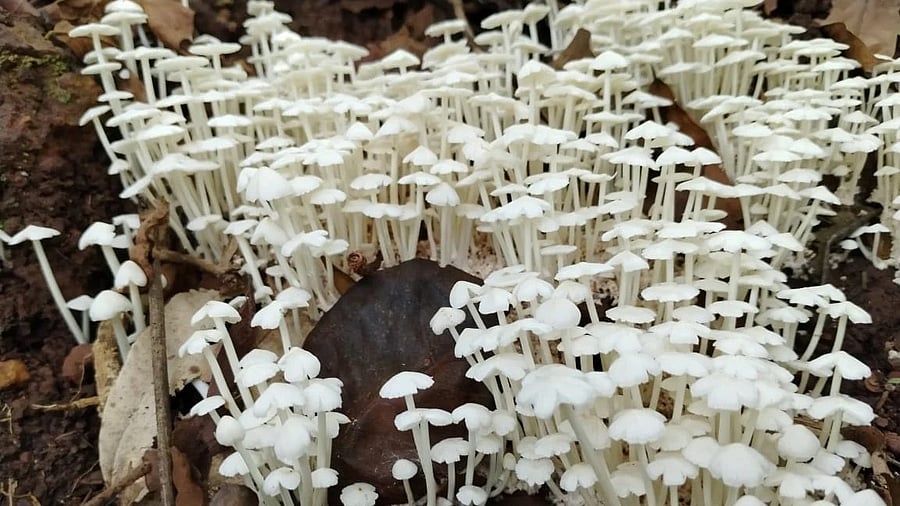
With nearly 83% of its geographical area covered by green forests, Joida taluk in Uttara Kannada district is a treasure trove of biodiversity. Throughout the monsoon, several parts of this semi-evergreen forest floor burst with wild mushrooms, locally known as pava, offering both food security and income to tribal communities.
For the Gavali and Kunbi communities of Joida, this seasonal abundance of diverse mushrooms is not merely a culinary celebration but a story of survival, tradition and an intimate, reciprocal relationship with the forest. Among the hundreds of mushroom varieties carpeting the undergrowth, the tribes harvest only five edible, protein-rich and medicinally valuable varieties.
Harvesting of mushrooms here begins in March and stretches to mid-October, but this year’s prolonged monsoon kept markets of Joida and nearby Dandeli, and the roads connecting them to Goa, busy with mushroom-laden leaf trays till early November.
Once the area receives the first pre-monsoon showers in mid-March, the tribal families head into the jungles of Anshi, Kundal, Nujji and surrounding villages in search of Shringara, a visually striking mushroom in shades of white and yellow. Shringara is among the most beautiful mushrooms available in the region and is sought-after for its delicate texture and mild flavour.
As the monsoon picks up, the tribal communities look for mushroom varieties such as Ravanaa, which grows only on anthills (Locally, ‘Ravan’ means anthill, giving the mushroom its name); Kutali, prized for its medicinal potency, deep-forest Fidga, a tribal favourite and others.
A majority of the tribal community in the Joida region is dependent on agriculture and with the region receiving between 5,000 mm and 7,000 mm of annual rainfall, cultivation of crops becomes nearly impossible between July and September. Until about five decades ago, the region would be cut off from the mainland for months, forcing tribes to rely on forest produce like tubers and mushrooms to endure the wet season.
“Mushrooms are our staple food during the monsoon as they provide us with the required proteins and keep us warm with their medicinal properties,” says Jayanand Derekar, president of the Joida Kunbi Samaj, an association of the tribal community.
He says these mushrooms, which grow only in the wild under specific climatic and habitat conditions, are more than just seasonal ingredients—they serve as indicators of the forest’s ecological health and rainfall patterns.
Bammu Phonde from the Gavali tribe knows the cycle like a calendar: “Shringara comes with mild rains and intermittent sunshine. Ravanaa grows only during the peak monsoon and we stop eating it after Ganesh Chaturthi. Kutali and Fidga are treasures found only deep in the forest. Kan requires dead wood logs and moist climate to grow. Any variation in the climate would result in them withering off or turning inedible.”
Mushroom trade
Until a decade ago, families collected these mushrooms from the forest only for their consumption. Excess mushrooms were sold casually, packed in just a leaf, by the roadside for those passing by. But the rising demand from Goa, Karwar and other cities for naturally grown mushrooms, which are known for their health value, mushroom trade has now become organised. Villagers now supply carefully packed mushrooms to nearby markets.
These mushrooms have found their way onto the menus of local eco-stays and homestays also. Narasimha Bhat Chapakanda, who runs a homestay near Dandeli, says, “Guests come specifically looking for mushroom dishes. The dishes made from these mushrooms are not only delicious but also healthy. Many of our guests visit us during monsoon just to enjoy these delicacies.”
Pava, a traditional dish of the tribal communities, has become one of the most sought-after cuisines in Goa. “The forests of Joida have hundreds of mushroom species and not all of them are edible. Only those knowing about it can distinguish between the edible and the harmful ones,” says Jayanand.
He also expresses concern that some people are now extracting this forest treasure in excess.
Mushrooms vanishing
Former faculty member of Sirsi Forestry College, Vinay Pai, has been observing a troubling pattern: some mushrooms, especially Kutali, are becoming scarce. “We do not yet know the exact reasons,” he says. “But their decline is a warning.”
Erratic rains have disrupted mushroom life cycles. “We cannot grow Shringara, Kutali or Fidga artificially,” he says. “If their habitats vanish, so will the traditions built around them.”
Mushrooms are sensitive organisms, reacting sharply to changes in rainfall patterns, soil conditions and forest-floor dynamics. Traditional practices like controlled burning of leaf litter to rejuvenate the soil have disappeared. While the forest department has largely restricted this practice to protect the forest, the result is thick, matted vegetation on the forest floor, which, in turn, prevents delicate fungal species from sprouting, Pai adds.